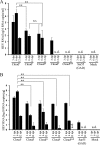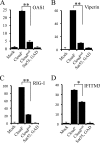Novel Synthesis and Phenotypic Analysis of Mutant Clouds for Hepatitis E Virus Genotype 1
- PMID: 29167341
- PMCID: PMC5790927
- DOI: 10.1128/JVI.01932-17
Novel Synthesis and Phenotypic Analysis of Mutant Clouds for Hepatitis E Virus Genotype 1
Abstract
Many RNA viruses exist as an ensemble of genetically diverse, replicating populations known as a mutant cloud. The genetic diversity (cloud size) and composition of this mutant cloud may influence several important phenotypic features of the virus, including its replication capacity. We applied a straightforward, bacterium-free approach using error-prone PCR coupled with reverse genetics to generate infectious mutant RNA clouds with various levels of genetic diversity from a genotype 1 strain of hepatitis E virus (HEV). Cloning and sequencing of a genomic fragment encompassing 70% of open reading frame 1 (ORF1) or of the full genome from variants in the resultant clouds showed the occurrence of nucleotide mutations at a frequency on the order of 10-3 per nucleotide copied and the existence of marked genetic diversity, with a high normalized Shannon entropy value. The mutant clouds showed transient replication in cell culture, while wild-type HEV did not. Cross-sectional data from these cell cultures supported the existence of differential effects of clouds of various sizes and compositions on phenotypic characteristics, such as the replication level of (+)-RNA progeny, the amounts of double-stranded RNA (a surrogate for the rate of viral replication) and ORF1 protein, and the expression of interferon-stimulated genes. Since mutant cloud size and composition influenced the viral phenotypic properties, a better understanding of this relationship may help to provide further insights into virus evolution and prediction of emerging viral diseases.IMPORTANCE Several biological or practical limitations currently prevent the study of phenotypic behavior of a mutant cloud in vitro We developed a simple and rapid method for synthesizing mutant clouds of hepatitis E virus (HEV), a single-stranded (+)-RNA [ss(+) RNA] virus, with various and controllable levels of genetic diversity, which could then be used in a cell culture system to study the effects of cloud size and composition on viral phenotype. In a cross-sectional analysis, we demonstrated that a particular mutant cloud which had an extremely high genetic diversity had a replication rate exceeding that of wild-type HEV. This method should thus provide a useful model for understanding the phenotypic behavior of ss(+) RNA viruses.
Keywords: error-prone PCR; genetic diversity; hepatitis E virus; mutant cloud; phenotype; quasispecies; random mutagenesis; reverse genetics.
Copyright © 2018 American Society for Microbiology.
Figures





Similar articles
-
Open Reading Frame 4 Is Not Essential in the Replication and Infection of Genotype 1 Hepatitis E Virus.Viruses. 2023 Mar 18;15(3):784. doi: 10.3390/v15030784. Viruses. 2023. PMID: 36992492 Free PMC article.
-
Recombinant Hepatitis E Viruses Harboring Tags in the ORF1 Protein.J Virol. 2019 Sep 12;93(19):e00459-19. doi: 10.1128/JVI.00459-19. Print 2019 Oct 1. J Virol. 2019. PMID: 31315997 Free PMC article.
-
The lysine residues within the human ribosomal protein S17 sequence naturally inserted into the viral nonstructural protein of a unique strain of hepatitis E virus are important for enhanced virus replication.J Virol. 2015 Apr;89(7):3793-803. doi: 10.1128/JVI.03582-14. Epub 2015 Jan 21. J Virol. 2015. PMID: 25609799 Free PMC article.
-
Reverse genetics approaches for hepatitis E virus and related viruses.Curr Opin Virol. 2020 Oct;44:121-128. doi: 10.1016/j.coviro.2020.07.004. Epub 2020 Aug 17. Curr Opin Virol. 2020. PMID: 32818718 Review.
-
Hepatitis E Virus Mutations: Functional and Clinical Relevance.EBioMedicine. 2016 Sep;11:31-42. doi: 10.1016/j.ebiom.2016.07.039. Epub 2016 Aug 6. EBioMedicine. 2016. PMID: 27528267 Free PMC article. Review.
Cited by
-
HCV Replicon Systems: Workhorses of Drug Discovery and Resistance.Front Cell Infect Microbiol. 2020 Jun 30;10:325. doi: 10.3389/fcimb.2020.00325. eCollection 2020. Front Cell Infect Microbiol. 2020. PMID: 32714881 Free PMC article. Review.
-
Genome-Wide Mutagenesis of Hepatitis C Virus Reveals Ability of Genome To Overcome Detrimental Mutations.J Virol. 2020 Jan 17;94(3):e01327-19. doi: 10.1128/JVI.01327-19. Print 2020 Jan 17. J Virol. 2020. PMID: 31723027 Free PMC article.
-
Glucose and glutamine drive hepatitis E virus replication.Arch Virol. 2024 Oct 30;169(11):233. doi: 10.1007/s00705-024-06160-x. Arch Virol. 2024. PMID: 39476184
References
-
- Domingo E, Martinez-Salas E, Sobrino F, de la Torre JC, Portela A, Ortin J, Lopez-Galindez C, Pérez-Brena P, Villanueva N, Najera R, VandePol S, Steinhauer D, DePolo N, Holland J. 1985. The quasispecies (extremely heterogeneous) nature of viral RNA genome populations: biological relevance—a review. Gene 40:1–8. - PubMed
Publication types
MeSH terms
Substances
LinkOut - more resources
Full Text Sources
Other Literature Sources

